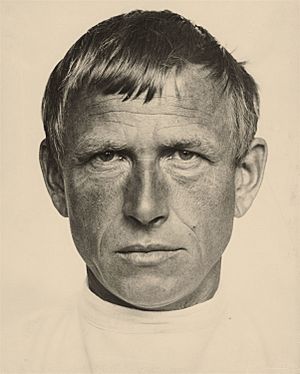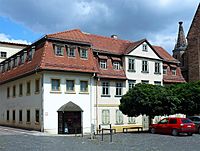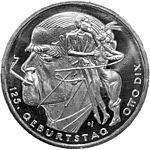Otto Dix facts for kids
Quick facts for kids
Otto Dix
|
|
|---|---|

Otto Dix (photograph by Hugo Erfurth, c. 1933)
|
|
| Born |
Wilhelm Heinrich Otto Dix
2 December 1891 Untermhaus, Reuß-Gera, German Empire (present-day Gera, Germany)
|
| Died | 25 July 1969 (aged 77) |
| Known for | Painting, printmaking |
| Movement | Expressionism, New objectivity, Dada |
| Spouse(s) |
Martha Koch
(m. 1923) |
| Awards | Iron Cross, 2nd class 1918 |
Wilhelm Heinrich Otto Dix (born December 2, 1891 – died July 25, 1969) was a famous German painter and printmaker. He was known for showing German society and the harshness of war in a very real and sometimes shocking way. He is considered one of the most important artists of a style called Neue Sachlichkeit, along with artists like George Grosz.
Contents
About Otto Dix
His Early Life and Art Training
Otto Dix was born in a town called Untermhaus, which is now part of Gera, Germany. His father worked in an iron factory, and his mother was a seamstress who enjoyed writing poetry. Otto was interested in art from a young age. He spent many hours with his cousin, Fritz Amann, who was also a painter. This helped him decide he wanted to be an artist.
From 1906 to 1910, he learned painting from Carl Senff. During this time, he started painting his first landscapes. In 1910, he went to an art school in Dresden. At first, his art focused on landscapes and portraits, using a realistic style. Later, his art changed to a style called Expressionism.
Otto Dix and World War I
When World War I began, Otto Dix joined the German Army. He was part of a machine-gun unit on the Western Front and fought in important battles like the Battle of the Somme. He was even wounded in the neck. He earned an award called the Iron Cross, 2nd class, for his bravery.
The war had a huge impact on Otto Dix. He saw terrible things, and these experiences stayed with him. He later said he often had nightmares about crawling through destroyed buildings. He used his art to show the horrors of war. For example, he created a series of fifty etchings called Der Krieg (meaning The War) in 1924. He also painted a large artwork called The War Triptych between 1929 and 1932, which also showed scenes from the war.
His Art After the War
After the war, Dix moved to Dresden and continued his art studies. He helped start an art group called the Dresden Secession in 1919. Around this time, his art was in an expressionist phase. In 1920, he met another artist, George Grosz. Dix started adding collage elements to his work, influenced by a movement called Dada.
In 1921, he met Martha Koch, a metalsmith, and they married in 1923. They had three children. Martha often appeared in his paintings.
By 1924, Dix's painting style became more realistic. He used thin layers of oil paint, similar to how old master painters worked. One of his paintings from 1923, called The Trench, caused a big stir. It showed the harsh reality of war so strongly that a museum even hid it behind a curtain!
Dix was part of the Neue Sachlichkeit (New Objectivity) art exhibition in 1925. His art, like that of his friend George Grosz, often criticized German society at the time.
Some of his most famous paintings include Sailor and Girl (1925) and the large artwork Metropolis (1928). Metropolis showed the wild parties and difficult times in Germany after the war. Another famous work is the striking Portrait of the Journalist Sylvia von Harden (1926). Dix also painted many pictures of war veterans who had lost limbs or were disfigured. These paintings showed the sad reality of how these forgotten heroes lived in Berlin in the 1920s.
Otto Dix During World War II and the Nazis
When the Nazi party came to power in Germany, they did not like Dix's art. They called it "degenerate art" because it didn't fit their ideas of what art should be. Dix was fired from his job as an art teacher at the Dresden Academy of Fine Arts. He then moved to Lake Constance in southwest Germany.
Some of Dix's paintings, like The Trench and War Cripples, were shown in a special exhibition in 1937 called Entartete Kunst (Degenerate Art). War Cripples was later burned. The Trench was thought to be destroyed too, but it might have survived until at least 1940.
Like all artists in Germany at the time, Dix was forced to join the Nazi government's art group. He had to promise to paint only harmless landscapes. However, he sometimes painted hidden messages in his art that criticized the Nazis. Some of his "degenerate" paintings were found years later in a secret collection.
During World War II, Dix was forced to join the Volkssturm, a German home guard. He was captured by French troops at the end of the war but was released in 1946.
His Later Life and Legacy
After the war, Otto Dix returned to Dresden. Many of his later paintings were about religious stories or showed the suffering people faced after the war. One example is his 1948 painting Ecce homo with self-likeness behind barbed wire.
Dix became well-known in both East and West Germany. He received many awards for his art, including the Grand Merit Cross of the Federal Republic of Germany in 1959. He was also made an honorary citizen of his hometown, Gera.
Otto Dix passed away on July 25, 1969, after having a stroke. He is buried in Hemmenhofen, near Lake Constance. He had three children: a daughter named Nelly and two sons, Ursus and Jan.
Otto Dix House Museums

There are two museums dedicated to Otto Dix.
Otto Dix House in Gera
The Otto-Dix-Haus opened in 1991 in the 18th-century house where Otto Dix was born and grew up in Gera. It is now a museum and art gallery.
The museum lets visitors see the rooms where Dix lived. It also has a large collection of his works, including about 400 drawings and paintings on paper. You can see his childhood sketchbooks, watercolors, drawings from the 1920s and 1930s, and lithographs. The museum also has 48 postcards he sent from the front during World War I. The gallery often hosts special temporary exhibitions.
The building was damaged by a flood in 2013 and was closed for repairs. It reopened in December 2016 after being restored.
Museum Haus Dix in Hemmenhofen
The Museum Haus Dix opened in 2013. This museum is in the house where Otto Dix lived and worked with his family from 1936 until his death in 1969. It is located in Hemmenhofen, in southern Germany.
See also
 In Spanish: Otto Dix para niños
In Spanish: Otto Dix para niños
- List of German painters




